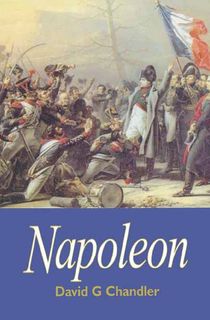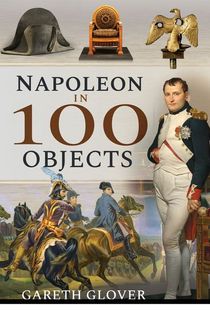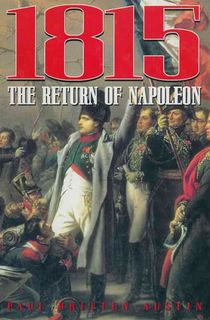Napoleon Bonaparte’s story has captured the imagination of movie makers ever since the pioneering cinematographer, Louis Lumiḕre, shot Entrevue de Napoleon et du Pope (Interview between Napoleon and the Pope) in the late 1890s. The latest cinematic take on the iconic French leader is due for release in late November 2023 and promises to be an action-packed historical epic. Directed by Ridley Scott, Napoleon will chart the Frenchman’s rise to power and his subsequent downfall, set against the backdrop of his turbulent relationship with his first wife, Josephine.
Napoleon has also long proved a source of fascination to history writers. Here are 10 fascinating books on different aspects of his life which are well worth a read, whether you’re planning on watching the new movie or simply wish to learn more about this iconic figure from French history.

The Rose of Martinique
Born on the Caribbean island of Martinique in 1763, Marie Josḕphe Rose Tascher de la Pagerie moved to Paris following her marriage to a French army officer at the age of just 16. Her first husband, Alexandre de Beauharnais, met an unfortunate end during the French Revolution, but it was her second marriage, three years later, to Napoleon Bonaparte which cemented her place in history as the Empress Josephine.
Andrea Stuart’s “comprehensive and truly empathetic” (Washington Post) biography of Josephine Bonaparte draws on contemporary diaries and letters to reveal the woman behind the myth. The Rose of Martinique provides invaluable insight into the remarkable journey made by this ambitious and resourceful woman from an unremarkable childhood on Martinique to her 1804 coronation as the Empress of France. Along the way, Stuart also delves deep into the complex and often tempestuous relationship between Napoleon and Josephine.

Waterloo
Published in 2015 to coincide with the 200th anniversary of the Battle of Waterloo, Paul O’Keeffe’s “highly readable” Waterloo explores what happened after the fighting ended with an in-depth investigation into the consequences of Napoleon’s defeat (Kirkus Reviews). The author reveals what happened in the immediate aftermath of this bloodiest of battles, depicting the grim reality of a battlefield strewn with the bodies of over 50,000 dead and wounded men. He also provides many fascinating insights into Napoleon’s fate post-Waterloo. This includes the story of the Frenchman’s thwarted attempt to escape to the United States, as well as the bizarre circumstances surrounding his short spell on HMS Bellerophon when he temporarily became an unlikely tourist attraction.

Napoleon
British historian David Chandler’s acclaimed biography was originally published in 1973, but Napoleon remains one of the classic accounts of the Frenchman’s life. Focusing primarily on Napoleon’s military career, Chandler excels in his analysis of the strategy and tactics employed by the French commander at some of the most hard-fought battles in world history, including Marengo, Austerlitz and Waterloo.

Napoleon in 100 Objects
In Napoleon in 100 Objects, Gareth Glover has come up with the interesting premise of utilizing 100 different items to discover the people, places and experiences that had the biggest impact on Napoleon’s life. Beginning with the humble Corsican home in which Napoleon was born and ending with the grandeur of his tomb in the Hotel des Invalides, Glover’s 100 objects are carefully chosen to illustrate the story of the Frenchman’s meteoric rise to power, his military successes and failures, and his eventual fall from grace. All this is set against the backdrop of the turbulent times in which he lived.

1815: The Return of Napoleon
Paul Britten Austin’s 1815: The Return of Napoleon focuses on events leading up to Waterloo, rather than the battle itself. He makes skillful use of contemporary eyewitness accounts to recreate the dramatic story of Napoleon’s escape from exile on the island of Elba and subsequent march on Paris during the period of French history now known as the Hundred Days. Austin has drawn on hundreds of firsthand accounts by Napoleon’s supporters and opponents to bring to life the seismic events that took place during the spring and early summer of 1815.

Waterloo
Many books have been published about the Battle of Waterloo, but nearly all of them tell the story from the perspective of the victorious British forces. In Waterloo: The French Perspective, Andrew W. Field has extensively researched French accounts of the battle to produce a contrasting version of events told from the viewpoint of the defeated army. Drawing on the stories of French soldiers from all ranks, Field reveals many fascinating new facts about the famous battle in this highly informative and engrossing account.

Bonaparte in Egypt
Long before Waterloo, Napoleon Bonaparte used a high-profile campaign in Egypt as a means of cementing his reputation as a military commander. The positive propaganda he generated from events there played a significant role in his rise to political power, culminating in his 1799 appointment as First Consul of the French Republic.
Originally published in 1962, J. Christopher Herold’s Bonaparte in Egypt is still widely regarded today as the most comprehensive and revealing account of this key point in Napoleon’s life, including detailed analysis of the military, political and cultural aspects of the campaign. Herold’s narrative is engaging and accessible, making this book an ideal read for anyone interested in learning more about this pivotal moment in French history.

Napoleon on Campaign
H.A. Carruthers’ Napoleon on Campaign tells Bonaparte’s story from a different perspective, using an array of artwork inspired by the French leader’s life and times to illustrate many of the most important moments in his career. The book includes some of the most famous Napoleon-themed paintings, including works by Horace Vernet, Ernest Meissonier and Elizabeth Butler. Presented chronologically in order of events, Napoleon on Campaign will particularly appeal to those who enjoy taking a visual approach to history.

To Kidnap A Pope: Napoleon and Pius VII
In contrast to the usual studies of Napoleon as a military commander, To Kidnap A Pope portrays the role played by the French leader in a quite different kind of conflict. Ambrogio A. Caiani’s “important and wonderfully written book” (New York Journal of Books) sheds new light on the turbulent relationship between Napoleon and Pope Pius VII, who proved just as tricky an opponent as any the Frenchman encountered on the battlefield. Initially, the pair had worked together to restore the Roman Catholic Church in France following the rift caused by the French Revolution. Caiani’s riveting account reveals how thereafter the relationship deteriorated rapidly, culminating in Napoleon’s order to arrest and imprison the Pope in 1809. This act would irrevocably change the relationship between the state and church in France.

Ambition and Desire: The Dangerous Life of Josephine Bonaparte
This “intelligent and entertaining” (Kirkus Reviews) biography by Kate Williams, British historian and broadcaster, charts the extraordinary life of Josephine Bonaparte. The author expertly brings together the different aspects of the Empress Josephine’s life to produce a compelling and well-rounded portrait of this remarkable woman. Josephine’s story is all too often told solely in the context of her marriage to Napoleon. Whilst Ambition and Desire includes plenty of interesting detail about their ultimately doomed relationship, it also has much else to say about Josephine and France in general during the revolutionary era.
This post is sponsored by Open Road Media. Thank you for supporting our partners, who make it possible for The Archive to continue publishing the history stories you love.




